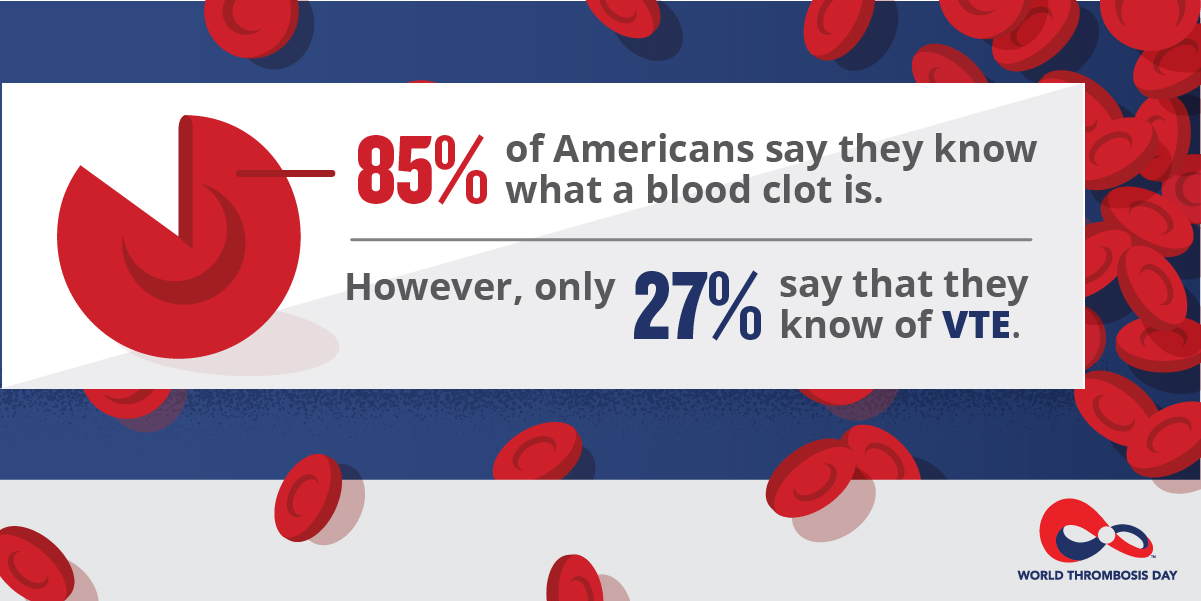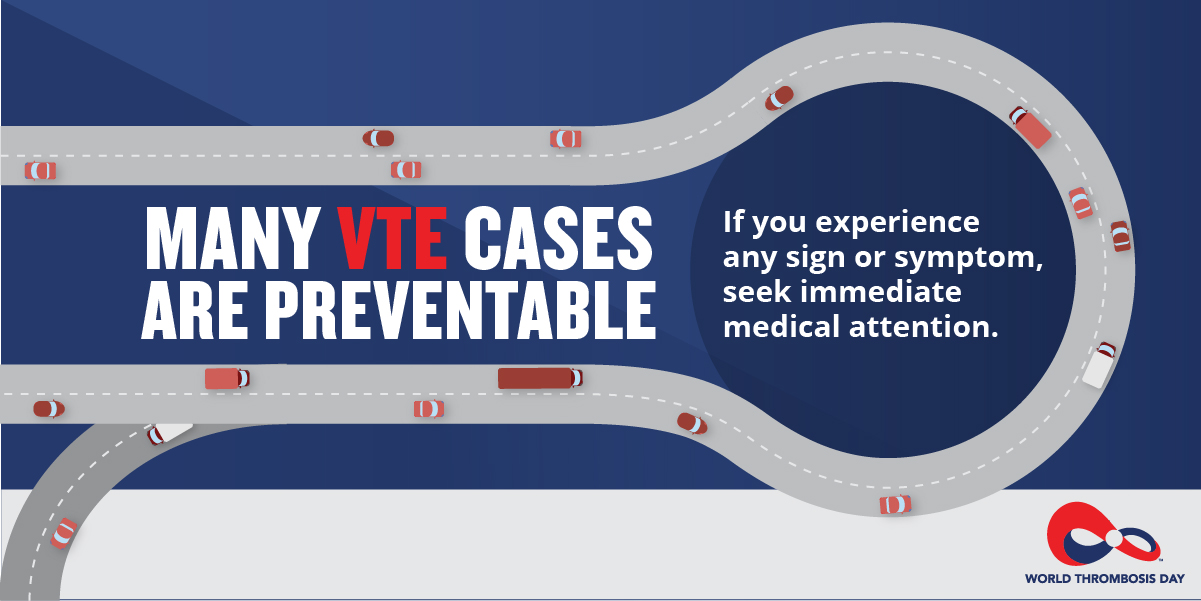Know Thrombosis: Think venous thromboembolism
Venous thromboembolism (VTE) is a condition in which a blood clot forms most often in the deep veins of the leg, groin or arm (known as deep vein thrombosis, DVT) and travels in the circulation, lodging in the lungs (known as pulmonary embolism, PE). Together, DVT and PE are known as VTE - a dangerous, potentially deadly medical condition.
Types of Thrombosis
- Deep vein thrombosis (DVT): A blood clot that forms in a deep vein, usually the leg, groin or arm.
- Pulmonary embolism (PE): A blood clot that occurs when a DVT clot breaks free from a vein wall and travels to the lungs blocking some or all of the blood supply. PE can often be fatal.
- DVT + PE = VTE: DVT and PE are collectively referred to as VTE.
 VTE is a leading cause of death and disability worldwide. A comprehensive scientific review by the WTD steering committee revealed that 10 million cases of VTE occur annually – across low, middle and high income countries. Yet, VTE-related death is largely undocumented with data predominantly confined to Europe and the United States. Read more about the findings.
VTE is a leading cause of death and disability worldwide. A comprehensive scientific review by the WTD steering committee revealed that 10 million cases of VTE occur annually – across low, middle and high income countries. Yet, VTE-related death is largely undocumented with data predominantly confined to Europe and the United States. Read more about the findings.
Just as concerning is that many people are not aware of this condition. A survey conducted by WTD and Ipsos-Reid found that global public awareness of thrombosis, DVT and PE is low, and much lower than awareness of other conditions like heart attack, stroke, hypertension, breast cancer, prostate cancer and AIDS. And, less than half of adults know that blood clots can be prevented. Read more about the survey findings.
Risk Factors
VTE does not discriminate. It affects people of all ages, races and ethnicities, and occurs in both men and women. Certain factors and situations can increase the risk of developing potentially deadly blood clots.
Strong Risk
- Being in the hospital for an extended period of time
-
Having surgery (especially hip, knee and cancer-related surgery)
- Cancer patients are at 4 times higher risk than the general population of developing serious blood clots.
- Not moving for long periods of time (e.g., due to bedrest or long-duration travel)
Moderate Risk
- Age (60+)
- Personal or family history of blood clots, recent stroke
- Cancer/chemotherapy
- Trauma
- Using estrogen-based medication (e.g., oral contraceptives or hormone replacement therapy)
Other Factors
- Obesity
- Pregnancy or recent birth
- Smoking
- Alcohol consumption
Warning Signs and Symptoms
VTE can occur without any warning signs or symptoms and can go unrecognized and undiagnosed by a healthcare professional. Symptoms that do appear may be associated with either DVT or PE.
Deep Vein Thrombosis (DVT)
- Pain or tenderness, often starting in the calf
- Swelling, including the ankle or foot
- Redness or noticeable discoloration
- Warmth
Pulmonary Embolism (PE)
- Unexplained shortness of breath
- Rapid breathing
- Chest pain (may be worse upon deep breath)
- Rapid heart rate
- Light headedness or passing out
Risk Assessment and Prevention
 Research suggests that VTEs are often preventable, and evidence-based prevention strategies can stop the development of clots in 'at-risk' individuals.
Research suggests that VTEs are often preventable, and evidence-based prevention strategies can stop the development of clots in 'at-risk' individuals.
To identify whether a patient is 'at-risk,' healthcare professionals should conduct a VTE risk assessment, which is tool or questionnaire that gathers information about a patient's age, medical history, medications and specific lifestyle factors. Information is then used to discern a patient’s potential risk (e.g., high, moderate or low risk) for developing blood clots in the legs or lungs.
If you are admitted to a hospital and don't receive an assessment, be proactive. Ask for one.
What are the most common tests my care team may order to see if I have a blood clot?
- A blood test called a D-Dimer
- An ultrasound of the arm or leg to look for the DVT
- A CAT scan of the chest with intravenous dye to look for a PE
Individuals who are deemed 'at-risk' should be given appropriate prevention (referred to as "prophylaxis"), which can include:
- Anti-clotting medications (e.g., blood thinners, referred to as "anticoagulants")
- Mechanical devices (e.g., compression stockings, intermittent pneumatic compression devices or rapid inflation venous foot pumps)
Hospital patients may also be instructed to move around or do foot/leg exercises as soon and as often as possible.
Treatment
DVT and PE are serious, life-threatening conditions that require immediate medical attention. Treatment can differ by patient but typically includes blood thinning medication to break up clots and prevent new ones from forming. Depending on specific conditions, a patient might need:
- Anticoagulants (e.g., injectables such as heparin, enoxaparin, or low molecular weight heparin, or tablets such as apixaban, dabigatran and rivaroxaban, edaxaban and warfarin)
- Mechanical devices (e.g., compression stockings which may decrease your risk of long term problems that can be caused from having clots or a special filter placed in a vein)
- Thrombolytic therapy (e.g., tissue plasminogen activator)
Early diagnosis and treatment can often lead to recovery, but long-term complications, such as post-thrombotic syndrome and chronic thromboembolic pulmonary hypertension may occur.
Facts and Figures
Are blood clots serious? Yes. VTE can cause problems that may affect you for the rest of your life. You may have long-term problems with breathing, a higher chance of getting another clot and swelling that will not go away. Additionally:
- Every year, there are approximately 10 million cases of VTE worldwide1
- In the U.S., there are 100,000 - 300,000 VTE-related deaths every year2
- In Europe, there are 544,000 VTE-related deaths every year3
- In the U.S. and Europe, VTE-related events kill more people than AIDS, breast cancer, prostate cancer and motor vehicle crashes combined.4
- Up to 60 percent of VTE cases occur during or after hospitalization, making it a leading preventable cause of hospital death.1
Economic Burden
In addition to disease burden, VTE can cause significant global economic burden. Multiple diagnostic tests and treatments, prolonged hospital stay and follow-up care - including recurrent VTE - can be extremely costly. But by focusing on VTE prevention, healthcare systems can save money, improve outcomes and ultimately save lives. Some countries have already begun implementing VTE policies and protocols that standardize - and even incentivize - hospital use of proper VTE prevention.
- In the U.K., VTE costs the National Health Service €640 million per year.5
- In the U.S., diagnosis and treatment of VTE costs $15.5 billion per year.6
- In Australia, VTE-related costs, including lost productivity, are estimated at $1.72 billion a year 7. When loss of wellbeing (disability and premature death) are included, the annual cost is $19.99 billion.
1 Jha AK, Larizgoitia I, Audera-Lopez C, Prasopa-Plaisier N, Waters H, Bates DW. The global burden of unsafe medical care: analytic modeling of observational studies. BMJ Qual Saf 2013; 22;809-15. Retrieved from: http://qualitysafety.bmj.com/content/22/10/809.full.pdf+html
2 US Department of Health and Human Services. Surgeon General's Call to Action to Prevent Deep Vein Thrombosis and Pulmonary Embolism 2008. Available at: http://www.surgeongeneral.gov/topics/deepvein.
3 Heit, JA. Poster 68 presented at: American Society of Hematology, 47th Annual Meeting, Atlanta, GA, December 10-13, 2005.
4 Cohen AT, Agnelli G, Anderson FA, et al. Venous thromboembolism (VTE) in Europe. Thromb Haemost. 2007;98:756-764.
5 House of Commons Health Committee Report on the Prevention of Venous Thromboembolism in Hospitalised Patients. www.publications.parliament.uk/pa/cm200405/cmselect/cmhealth/99/9902.html.
6 Medscape. Medscape General Medicine. 2004:6(3)5.
7 According to data from the international studies (Voskanyan J.E. et al, Organization standardized prevention of venous thromboembolic events in a multidisciplinary hospital, Surgery Volume 08-N2-2006, on average the frequency of hospital deaths from PE stands at 0.3%
